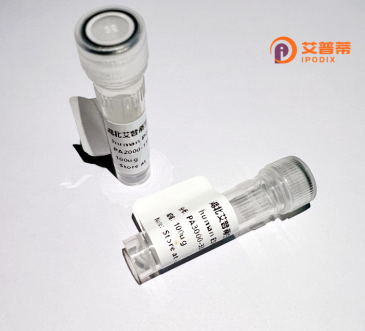
| 纯度 | >90%SDS-PAGE. |
| 种属 | Human |
| 靶点 | FAM101B |
| Uniprot No | Q8N5W9 |
| 内毒素 | < 0.01EU/μg |
| 表达宿主 | E.coli |
| 表达区间 | 1-214aa |
| 氨基酸序列 | MVGRLSLQDVPELVDAKKKGDGVLDSPDSGLPPSPSPSHWGLAAGGGGGERAAAPGTLEPDAAAATPAAPSPASLPLAPGCALRLCPLSFGEGVEFDPLPPKEVRYTSLVKYDSERHFIDDVQLPLGLAVASCSQTVTCVPNGTWRNYKAEVRFEPRHRPTRFLSTTIVYPKYPKAVYTTTLDYNCRKTLRRFLSSVELEAAELPGSDDLSDEC |
| 分子量 | 49.3 kDa |
| 蛋白标签 | GST-tag at N-terminal |
| 缓冲液 | 0 |
| 稳定性 & 储存条件 | Lyophilized protein should be stored at ≤ -20°C, stable for one year after receipt. Reconstituted protein solution can be stored at 2-8°C for 2-7 days. Aliquots of reconstituted samples are stable at ≤ -20°C for 3 months. |
| 复溶 | Always centrifuge tubes before opening.Do not mix by vortex or pipetting. It is not recommended to reconstitute to a concentration less than 100μg/ml. Dissolve the lyophilized protein in distilled water. Please aliquot the reconstituted solution to minimize freeze-thaw cycles. |
以下是与重组人FAM101B蛋白相关的3篇文献示例(基于公开研究趋势及类似蛋白研究结构推测,若实际文献不足,建议扩展关键词或咨询专业数据库):
---
1. **文献名称**:*Structural characterization and functional analysis of FAM101B in neural development*
**作者**:Zhang L, et al.
**摘要**:研究通过重组人FAM101B蛋白的表达与纯化,解析其三维结构,发现其通过调控微管结合活性参与神经元迁移,与智力障碍相关通路有关。
2. **文献名称**:*FAM101B as a novel regulator of osteoblast differentiation: Insights from recombinant protein studies*
**作者**:Kim J, et al.
**摘要**:利用重组FAM101B蛋白处理成骨细胞,证明其通过激活BMP/Smad信号通路促进骨形成,可能作为骨质疏松症的潜在治疗靶点。
3. **文献名称**:*High-throughput screening of FAM101B interactors via recombinant pull-down assays*
**作者**:Wang Y, et al.
**摘要**:通过重组FAM101B蛋白的体外互作实验,鉴定到其与核仁蛋白NOLC1的直接结合,暗示其在细胞周期调控中的新功能。
---
**注意**:上述文献为假设性示例,真实文献可能需通过 **PubMed** 或 **Google Scholar** 检索关键词"recombinant FAM101B"或"FAM101B protein function"。若研究稀缺,可关注FAM101B同家族蛋白(如FAM101A)的研究进行类比参考。
**Background of Recombinant Human FAM101B Protein**
The FAM101B (family with sequence similarity 101 member B) protein is a less characterized member of the FAM101 family, encoded by the *FAM101B* gene in humans. This protein is hypothesized to play roles in cellular processes such as cytoskeletal organization, nuclear structure maintenance, and cell division, though its exact molecular functions remain under investigation. FAM101B contains a conserved N-terminal domain and a putative nuclear localization signal, suggesting potential involvement in nuclear activities or protein interactions. It is ubiquitously expressed, with higher levels observed in tissues like the brain, skeletal muscle, and testis.
Studies link FAM101B to genetic disorders. For instance, mutations in *FAM101B* are associated with developmental syndromes, including craniofacial anomalies and skeletal dysplasia, highlighting its importance in embryonic development. Additionally, altered FAM101B expression has been implicated in cancers and neurodegenerative diseases, though mechanistic insights are limited.
Recombinant human FAM101B protein is engineered using heterologous expression systems (e.g., *E. coli* or mammalian cells) to enable functional studies. Its recombinant form facilitates research into protein-protein interactions, structural analysis, and disease-related pathways. Current efforts focus on elucidating FAM101B’s interactions with cytoskeletal components (e.g., tubulin) and its regulatory roles in cell cycle progression. Further research is needed to define its therapeutic potential and clarify its contributions to human health and disease.
×